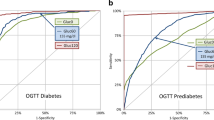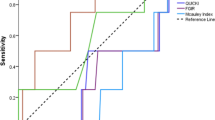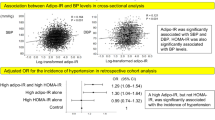Abstract
Background/Objectives:
Insulin resistance is the major contributor to cardiometabolic complications of obesity. We aimed to (1) establish cutoff points for insulin resistance from euglycemic hyperinsulinemic clamps (EHCs), (2) identify insulin-resistant obese subjects and (3) predict insulin resistance from routinely measured variables.
Subjects/Methods:
We assembled data from non-obese (n=112) and obese (n=100) men who underwent two-step EHCs using [6,6-2H2]glucose as tracer (insulin infusion dose 20 and 60 mU m−2 min−1, respectively). Reference ranges for hepatic and peripheral insulin sensitivity were calculated from healthy non-obese men. Based on these reference values, obese men with preserved insulin sensitivity or insulin resistance were identified.
Results:
Cutoff points for insulin-mediated suppression of endogenous glucose production (EGP) and insulin-stimulated glucose disappearance rate (Rd) were 46.5% and 37.3 μmol kg−1 min−1, respectively. Most obese men (78%) had EGP suppression within the reference range, whereas only 12% of obese men had Rd within the reference range. Obese men with Rd <37.3 μmol kg−1 min−1 did not differ from insulin-sensitive obese men in age, body mass index (BMI), body composition, fasting glucose or cholesterol, but did have higher fasting insulin (110±49 vs 63±29 pmol l−1, P<0.001) and homeostasis model assessment of insulin resistance (HOMA-IR) (4.5±2.2 vs 2.7±1.4, P=0.004). Insulin-resistant obese men could be identified with good sensitivity (80%) and specificity (75%) from fasting insulin >74 pmol l−1.
Conclusions:
Most obese men have hepatic insulin sensitivity within the range of non-obese controls, but below-normal peripheral insulin sensitivity, that is, insulin resistance. Fasting insulin (>74 pmol l−1 with current insulin immunoassay) may be used for identification of insulin-resistant (or metabolically unhealthy) obese men in research and clinical settings.
This is a preview of subscription content, access via your institution
Access options
Subscribe to this journal
Receive 12 print issues and online access
$259.00 per year
only $21.58 per issue
Buy this article
- Purchase on Springer Link
- Instant access to full article PDF
Prices may be subject to local taxes which are calculated during checkout




Similar content being viewed by others
References
Zimmet P, Alberti KG, Shaw J . Global and societal implications of the diabetes epidemic. Nature 2001; 414: 782–787.
Accili D . Lilly lecture 2003: the struggle for mastery in insulin action: from triumvirate to republic. Diabetes 2004; 53: 1633–1642.
Kahn SE, Hull RL, Utzschneider KM . Mechanisms linking obesity to insulin resistance and type 2 diabetes. Nature 2006; 444: 840–846.
Muniyappa R, Lee S, Chen H, Quon MJ . Current approaches for assessing insulin sensitivity and resistance in vivo: advantages, limitations, and appropriate usage. Am J Physiol Endocrinol Metab 2008; 294: E15–E26.
Samocha-Bonet D, Chisholm DJ, Tonks K, Campbell LV, Greenfield JR . Insulin-sensitive obesity in humans - a 'favorable fat' phenotype? Trends Endocrinol Metab 2012; 23: 116–124.
Stern SE, Williams K, Ferrannini E, DeFronzo RA, Bogardus C, Stern MP . Identification of individuals with insulin resistance using routine clinical measurements. Diabetes 2005; 54: 333–339.
Tam CS, Xie W, Johnson WD, Cefalu WT, Redman LM, Ravussin E . Defining insulin resistance from hyperinsulinemic-euglycemic clamps. Diabetes Care 2012; 35: 1605–1610.
Gast KB, Tjeerdema N, Stijnen T, Smit JW, Dekkers OM . Insulin resistance and risk of incident cardiovascular events in adults without diabetes: meta-analysis. PLoS One 2012; 7: e52036.
Knowler WC, Barrett-Connor E, Fowler SE, Hamman RF, Lachin JM, Walker EA et al. Reduction in the incidence of type 2 diabetes with lifestyle intervention or metformin. N Engl J Med 2002; 346: 393–403.
Langeveld M, Ghauharali KJ, Sauerwein HP, Ackermans MT, Groener JE, Hollak CE et al. Type I Gaucher disease, a glycosphingolipid storage disorder, is associated with insulin resistance. J Clin Endocrinol Metab 2008; 93: 845–851.
Vrieze A, Van Nood E, Holleman F, Salojarvi J, Kootte RS, Bartelsman JF et al. Transfer of intestinal microbiota from lean donors increases insulin sensitivity in individuals with metabolic syndrome. Gastroenterology 2012; 143: 913–916.
de Weijer BA, Aarts E, Janssen IM, Berends FJ, van de Laar A, Kaasjager K et al. Hepatic and peripheral insulin sensitivity do not improve 2 weeks after bariatric surgery. Obesity 2013; 21: 1143–1147.
Koopman KE, Caan MW, Nederveen AJ, Pels A, Ackermans MT, Fliers E et al. Hypercaloric diets with increased meal frequency, but not meal size, increase intrahepatic triglycerides: a randomized controlled trial. Hepatology 2014; 60: 545–553.
van Raalte DH, Brands M, van der Zijl NJ, Muskiet MH, Pouwels PJ, Ackermans MT et al. Low-dose glucocorticoid treatment affects multiple aspects of intermediary metabolism in healthy humans: a randomised controlled trial. Diabetologia 2011; 54: 2103–2112.
Brands M, Sauerwein HP, Ackermans MT, Kersten S, Serlie MJ . Omega-3 long-chain fatty acids strongly induce angiopoietin-like 4 in humans. J Lipid Res 2013; 54: 615–621.
Vrieze A, Out C, Fuentes S, Jonker L, Reuling I, Kootte RS et al. Impact of oral vancomycin on gut microbiota, bile acid metabolism, and insulin sensitivity. J Hepatol 2014; 60: 824–831.
van der Valk F, Hassing C, Visser M, Thakkar P, Mohanan A, Pathak K et al. The effect of a diiodothyronine mimetic on insulin sensitivity in male cardiometabolic patients: a double-blind randomized controlled trial. PLoS One 2014; 9: e86890.
Ackermans MT, Pereira Arias AM, Bisschop PH, Endert E, Sauerwein HP, Romijn JA . The quantification of gluconeogenesis in healthy men by (2)H2O and [2-(13)C]glycerol yields different results: rates of gluconeogenesis in healthy men measured with (2)H2O are higher than those measured with [2-(13)C]glycerol. J Clin Endocrinol Metab 2001; 86: 2220–2226.
Matthews DR, Hosker JP, Rudenski AS, Naylor BA, Treacher DF, Turner RC . Homeostasis model assessment: insulin resistance and beta-cell function from fasting plasma glucose and insulin concentrations in man. Diabetologia 1985; 28: 412–419.
Katz A, Nambi SS, Mather K, Baron AD, Follmann DA, Sullivan G et al. Quantitative insulin sensitivity check index: a simple, accurate method for assessing insulin sensitivity in humans. J Clin Endocrinol Metab 2000; 85: 2402–2410.
Steele R . Influences of glucose loading and of injected insulin on hepatic glucose output. Ann NY Acad Sci 1959; 82: 420–430.
Finegood DT, Bergman RN, Vranic M . Estimation of endogenous glucose production during hyperinsulinemic-euglycemic glucose clamps. Comparison of unlabeled and labeled exogenous glucose infusates. Diabetes 1987; 36: 914–924.
Solberg HE . The theory of reference values Part 5. Statistical treatment of collected reference values. Determination of reference limits. J Clin Chem Clin Biochem 1983; 21: 749–760.
Clinical and Laboratory Standards Institute Defining, Establishing, and Verifying Reference Intervals in the Clinical Laboratory: Approved Guideline, 3rd edn. CLSI document EP28-A3c Clinical and Laboratory Standards Institute: Wayne, PA, USA, 2008.
Karakelides H, Irving BA, Short KR, O'Brien P, Nair KS . Age, obesity, and sex effects on insulin sensitivity and skeletal muscle mitochondrial function. Diabetes 2010; 59: 89–97.
Vistisen D, Colagiuri S, Borch-Johnsen K . Bimodal distribution of glucose is not universally useful for diagnosing diabetes. Diabetes Care 2009; 32: 397–403.
Reaven GM . Banting lecture 1988: role of insulin resistance in human disease. Diabetes 1988; 37: 1595–1607.
Amati F, Dube JJ, Coen PM, Stefanovic-Racic M, Toledo FG, Goodpaster BH . Physical inactivity and obesity underlie the insulin resistance of aging. Diabetes Care 2009; 32: 1547–1549.
American Diabetes Association. Diagnosis and classification of diabetes mellitus. Diabetes Care 2014; 37: S81–S90.
Goff DC Jr, Lloyd-Jones DM, Bennett G, Coady S, D’Agostino RB Sr, Gibbons R et al. 2013 ACC/AHA guideline on the assessment of cardiovascular risk: a report of the American College of Cardiology/American Heart Association Task Force on Practice Guidelines. J Am Coll Cardiol 2014; 63: 2935–2959.
Ferrannini E, Natali A, Bell P, Cavallo-Perin P, Lalic N, Mingrone G . Insulin resistance and hypersecretion in obesity. J Clin Invest 1997; 100: 1166–1173.
Stefan N, Kantartzis K, Machann J, Schick F, Thamer C, Rittig K et al. Identification and characterization of metabolically benign obesity in humans. Arch Intern Med 2008; 168: 1609–1616.
Ozturk ZA, Kadayifci A . Insulin sensitizers for the treatment of non-alcoholic fatty liver disease. World J Hepatol 2014; 6: 199–206.
Smith-Marsh D . Pharmacological strategies for preventing type 2 diabetes in patients with impaired glucose tolerance. Drugs Today (Barc) 2013; 49: 499–507.
DeFronzo RA, Tripathy D . Skeletal muscle insulin resistance is the primary defect in type 2 diabetes. Diabetes Care 2009; 32: S157–S163.
Paquot N, Scheen AJ, Dirlewanger M, Lefebvre PJ, Tappy L . Hepatic insulin resistance in obese non-diabetic subjects and in type 2 diabetic patients. Obes Res 2002; 10: 129–134.
Sherwin RS, Kramer KJ, Tobin JD, Insel PA, Liljenquist JE, Berman M et al. A model of the kinetics of insulin in man. J Clin Invest 1974; 53: 1481–1492.
Doberne L, Greenfield MS, Schulz B, Reaven GM . Enhanced glucose utilization during prolonged glucose clamp studies. Diabetes 1981; 30: 829–835.
Miller WG, Thienpont LM, Van Uytfanghe K, Clark PM, Lindstedt P, Nilsson G et al. Towards standardization of insulin immunoassays. Clin Chem 2009; 55: 1011–1018.
Staten MA, Stern MP, Miller WG, Steffes MW, Campbell SE . Insulin assay standardization: leading to measures of insulin sensitivity and secretion for practical clinical care. Diabetes Care 2010; 33: 205–206.
Acknowledgements
No specific funding was received for the present study. KWH, PWG and MJS are supported by an EU grant (FP7-EU 305707). RSK is supported by a TIFN grant (2011 G003). MN is supported by VIDI and CVON grants (016.146.327 and 2012 IN-CONTROL). KWH performed the analysis, contributed to discussions about the results and wrote the manuscript. PWG, KEK, BAW, MB and RSK researched data and reviewed and approved the final manuscript. MTA was responsible for laboratory analyses and reviewed and approved the final manuscript. JAR, MN, MRS and MJS contributed to discussions about the results and reviewed and approved the final manuscript. MJS is the guarantor of this work, had full access to all data and takes responsibility for the integrity of the results.
Author information
Authors and Affiliations
Corresponding author
Ethics declarations
Competing interests
The authors declare no conflict of interest.
Additional information
Supplementary Information accompanies this paper on International Journal of Obesity website
Supplementary information
Rights and permissions
About this article
Cite this article
ter Horst, K., Gilijamse, P., Koopman, K. et al. Insulin resistance in obesity can be reliably identified from fasting plasma insulin. Int J Obes 39, 1703–1709 (2015). https://doi.org/10.1038/ijo.2015.125
Received:
Revised:
Accepted:
Published:
Issue Date:
DOI: https://doi.org/10.1038/ijo.2015.125
This article is cited by
-
Brain responses to nutrients are severely impaired and not reversed by weight loss in humans with obesity: a randomized crossover study
Nature Metabolism (2023)
-
Identifying molecular mediators of the relationship between body mass index and endometrial cancer risk: a Mendelian randomization analysis
BMC Medicine (2022)
-
The Ideal Insulin Resistance Index for Cardiovascular Risk Discrimination in Type 2 Diabetes Mellitus
SN Comprehensive Clinical Medicine (2021)
-
Effect of dipeptidyl-peptidase-4 inhibitors on C-reactive protein in patients with type 2 diabetes: a systematic review and meta-analysis
Lipids in Health and Disease (2019)
-
Meal timing effects on insulin sensitivity and intrahepatic triglycerides during weight loss
International Journal of Obesity (2018)



